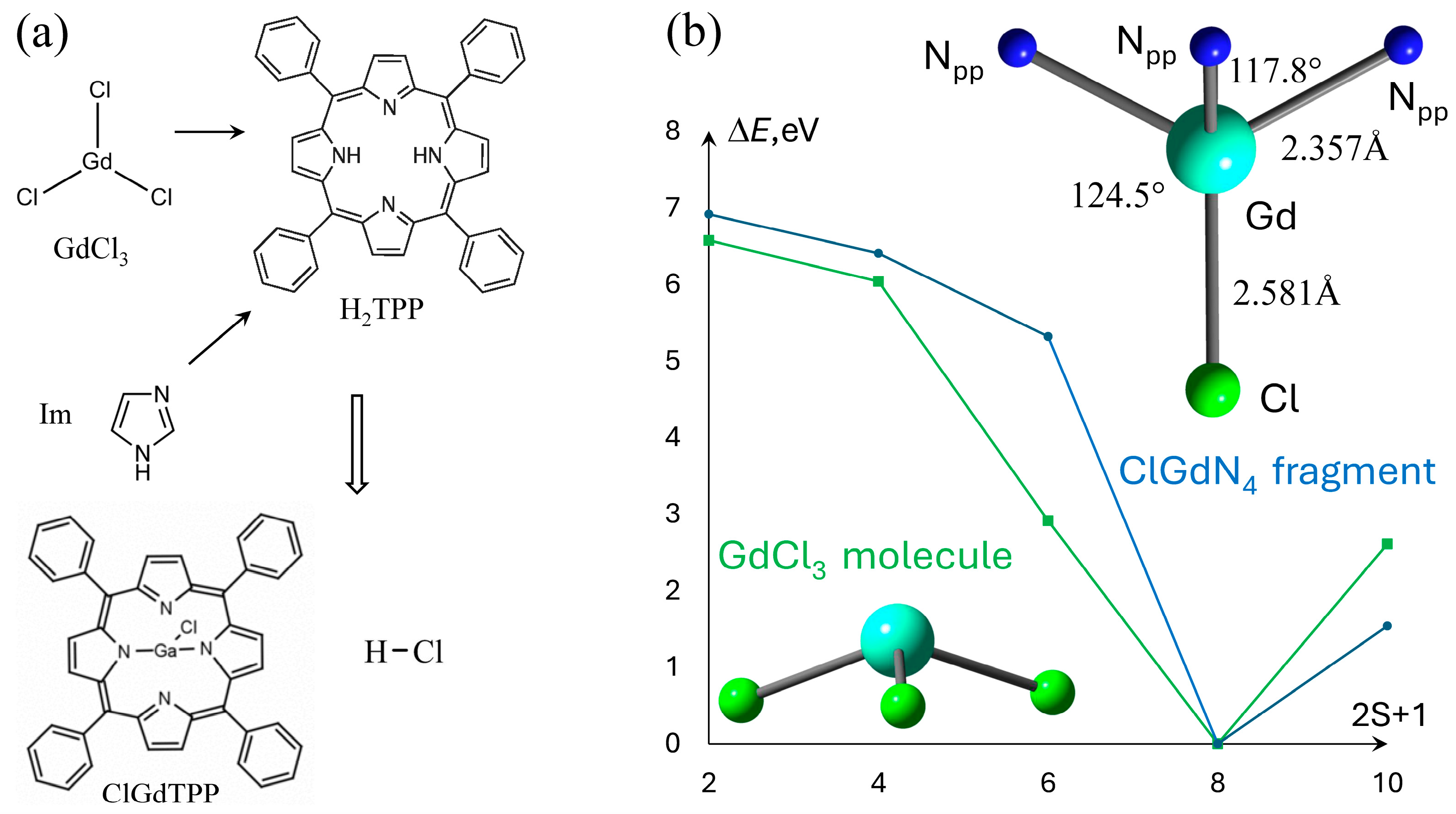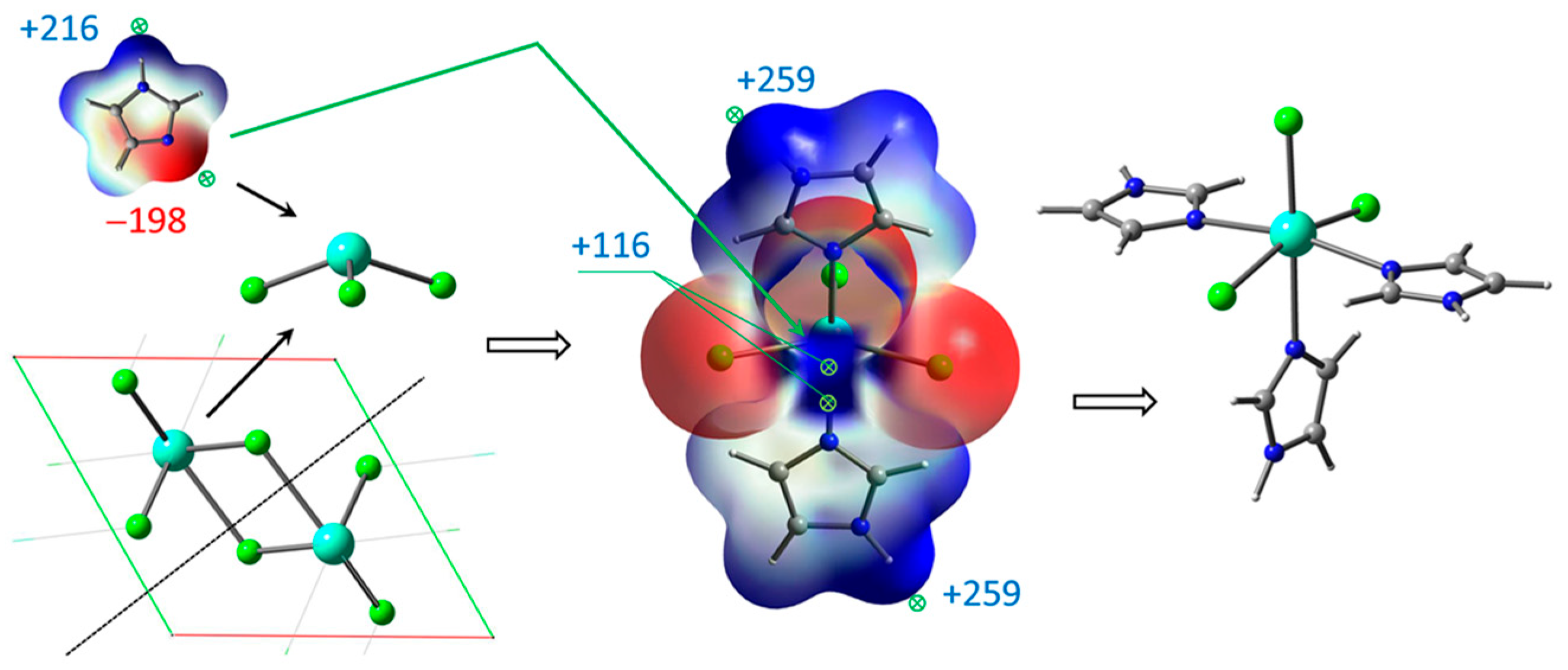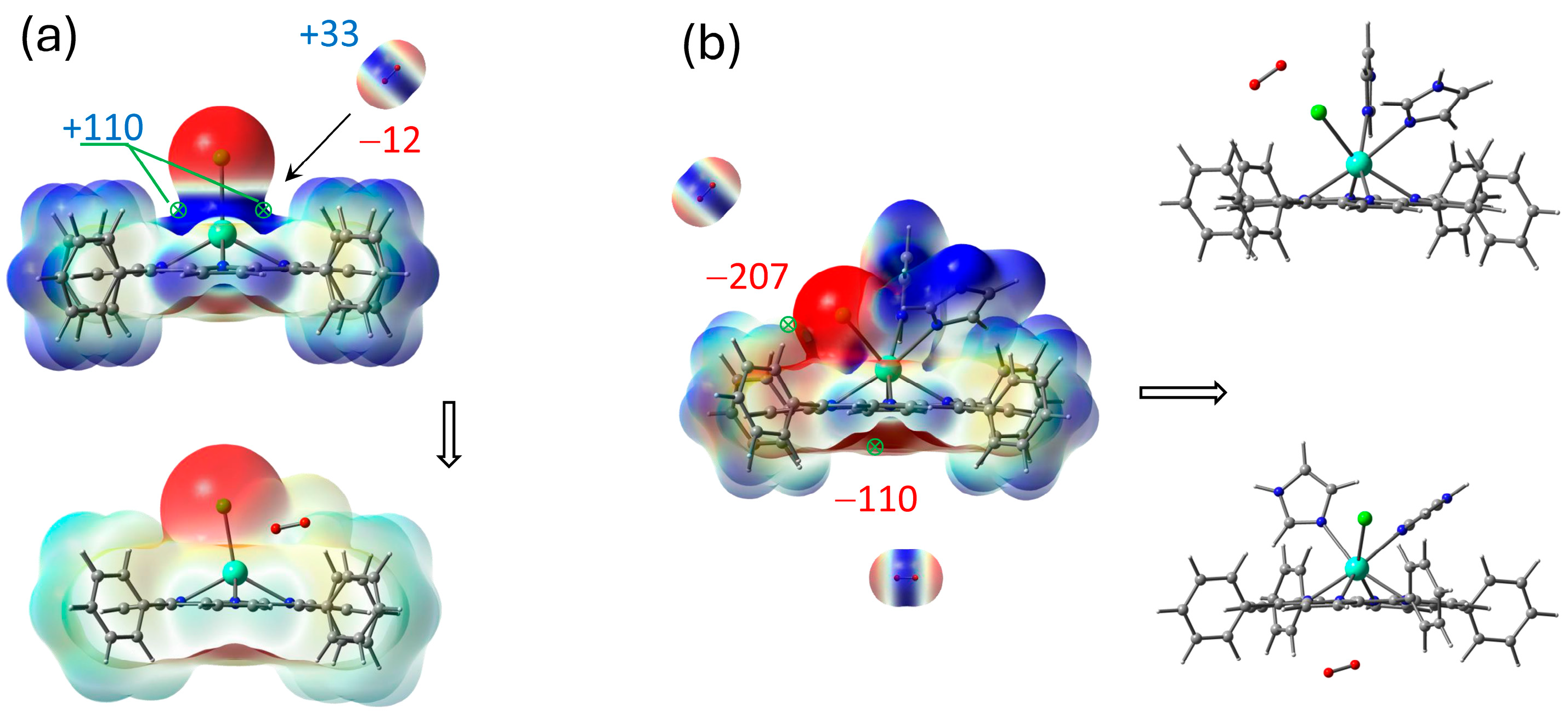Computational Modelling of Imidazole Protection of Coordinated Gadolinium Tetraphenylporphyrine Against Molecular Oxygen Attack
Abstract
1. Introduction
2. Results and Discussion
2.1. Molecular Structure and Spin Multiplicity
2.2. ClGdTPP Formation and Coordination with Imidazole Ligands
2.3. Coordination Sphere Parameters of ClGdTPP·Im vs. ClGdTPP·2Im
2.4. Molecular Oxygen Attack on GdTPP Complex with Imidazole Ligands
3. Computational Methods
4. Conclusions
Supplementary Materials
Author Contributions
Funding
Institutional Review Board Statement
Informed Consent Statement
Data Availability Statement
Acknowledgments
Conflicts of Interest
References
- Khalil, G.E.; Thompson, E.K.; Gouterman, M.; Callis, J.B.; Dalton, L.R.; Turro, N.J.; Jockusch, S. NIR Luminescence of Gadolinium Porphyrin Complexes. Chem. Phys. Lett. 2007, 435, 45–49. [Google Scholar] [CrossRef]
- Liu, T.; Zhang, X.; Zhang, H.; Zhao, H.; Zhang, Z.; Tian, Y. Kinetics Process of Room Temperature Phosphorescence and Fluorescence of Gadolinium Porphyrin in Aqueous Solution. J. Rare Earths 2021, 39, 1187–1193. [Google Scholar] [CrossRef]
- Kalota, B.; Tsvirko, M. Fluorescence and Phosphorescence of Lutetium(III) and Gadolinium(III) Porphyrins for the Intraratiometric Oxygen Sensing. Chem. Phys. Lett. 2015, 634, 188–193. [Google Scholar] [CrossRef]
- Zhao, H.; Zang, L.; Qin, F.; Wang, P.; Zhao, H.; Zhang, Z.; Cao, W. Nonlinear Phosphorescence Quenching Mechanism of Gadolinium Labeled Porphyrin by Oxygen on Filter Paper. J. Photochem. Photobiol. A Chem. 2016, 316, 7–11. [Google Scholar] [CrossRef]
- Zang, L.; Zhao, H.; Hua, J.; Qin, F.; Zheng, Y.; Zhang, Z.; Cao, W. Ratiometric Oxygen Sensing Using the Tunable Ratio of Phosphorescence to Fluorescence Emissions from Gadolinium Porphyrin and Porphyrin. J. Lumin. 2017, 183, 452–457. [Google Scholar] [CrossRef]
- Zang, L.; Zhao, H. Stabilization of a Gadolinium(III)-Porphyrin in Aqueous Solution for Oxygen Sensing. Dye. Pigment. 2020, 183, 108731. [Google Scholar] [CrossRef]
- Wang, J.; Wang, Z.; Zhong, Y.; Zou, Y.; Wang, C.; Wu, H.; Lee, A.; Yang, W.; Wang, X.; Liu, Y.; et al. Central Metal-Derived Co-Assembly of Biomimetic GdTPP/ZnTPP Porphyrin Nanocomposites for Enhanced Dual-Modal Imaging-Guided Photodynamic Therapy. Biomaterials 2020, 229, 119576. [Google Scholar] [CrossRef]
- Zang, L.; Zhao, H.; Hua, J.; Qin, F.; Zheng, Y.; Zhang, Z.; Cao, W. Water-Soluble Gadolinium Porphyrin as a Multifunctional Theranostic Agent: Phosphorescence-Based Oxygen Sensing and Photosensitivity. Dye. Pigment. 2017, 142, 465–471. [Google Scholar] [CrossRef]
- Zhao, H.; Zang, L.; Zhao, H.; Qin, F.; Li, Z.; Zhang, Z.; Cao, W. Mechanism of Gadolinium Doping Induced Room-Temperature Phosphorescence from Porphyrin. J. Phys. Chem. C 2015, 119, 10558–10563. [Google Scholar] [CrossRef]
- Zang, L.; Zhao, H. Correlation between the Triplet-State Energy of Metalloporphyrins and Oxygen Response of Their Phosphorescence. J. Phys. Chem. C 2020, 124, 25004–25009. [Google Scholar] [CrossRef]
- Kou, M.; Qin, F.; Wang, Y.; Zhang, X.; Zhao, H.; Tian, Y.; Zhang, Z. Intrinsic Characterization Method on the Heavy Atom Effect of Metalloporphyrins. Inorg. Chem. 2022, 61, 15175–15181. [Google Scholar] [CrossRef]
- Yang, J.; Huang, P. A Study of Cobalt(II) Porphyrins on Their Oxygen-Binding Behaviors and Oxygen-Facilitated Transport Properties in Polymeric Membranes. Chem. Mater. 2000, 12, 2693–2697. [Google Scholar] [CrossRef]
- Yang, J.; Li, P.; Li, X.; Xie, L.; Wang, N.; Lei, H.; Zhang, C.; Zhang, W.; Lee, Y.; Zhang, W.; et al. Crucial Roles of a Pendant Imidazole Ligand of a Cobalt Porphyrin Complex in the Stoichiometric and Catalytic Reduction of Dioxygen. Angew. Chem. Int. Ed. 2022, 61, e202208143. [Google Scholar] [CrossRef]
- Barkigia, K.M.; Renner, M.W.; Senge, M.O.; Fajer, J. Interplay of Axial Ligation, Hydrogen Bonding, Self-Assembly, and Conformational Landscapes in High-Spin Ni(II) Porphyrins. J. Phys. Chem. B 2004, 108, 2173–2180. [Google Scholar] [CrossRef]
- Wang, S.; Peng, Y.; Zhang, C.; Li, Y.; Liu, C. Synthesis of a Series of Zinc Porphyrins and Spectroscopic Changes upon Coordination Reaction with Imidazole Derivatives. Bull. Korean Chem. Soc. 2015, 36, 2693–2702. [Google Scholar] [CrossRef]
- Srivastava, T.S. Lanthanide Octaethylprophyrins: Preparation, Association, and Interaction with Axial Ligands. Bioinorg. Chem. 1978, 8, 61–76. [Google Scholar] [CrossRef]
- Berezin, D.B.; Bonnett, R.; De Madariaga, M.A.; Molina, S.I.; Mora, M.; Sagrista, M.L.; Valles, M.A. Gd-Meso-Tetraphenylporphyrins: Synthesis, Encapsulation into Liposomes, and Characterization of the Resulting Preparations. In Photochemotherapy: Photodynamic Therapy and Other Modalities III; Berg, K., Ehrenberg, B., Malik, Z., Moan, J., Katzir, A., Eds.; SPIE: San Remo, Italy, 1997; pp. 359–367. [Google Scholar]
- Zang, L.; Zhao, H.; Hua, J.; Qin, F.; Zheng, Y.; Zhang, Z.; Cao, W. The Effect of Imidazole on the Enhancement of Gadolinium-Porphyrin Phosphorescence at Room Temperature. Dalton Trans. 2016, 45, 16889–16895. [Google Scholar] [CrossRef]
- Zang, L.; Wang, H.; Wang, Z.; Wang, S.; Yu, M.; Kang, Q.; Zou, G.; Zhao, H. Competition and Regulation between Triplet Phosphorescence and Singlet Oxygen Generation Efficiency. J. Lumin. 2022, 244, 118723. [Google Scholar] [CrossRef]
- Antony, J.; Grodzicki, M.; Trautwein, A.X. Local Density Functional Study of Oxoiron(IV) Porphyrin Complexes and Their One-Electron Oxidized Derivatives. Axial Ligand Effects. J. Phys. Chem. A 1997, 101, 2692–2701. [Google Scholar] [CrossRef]
- Kitagawa, Y.; Chen, Y.; Nakatani, N.; Nakayama, A.; Hasegawa, J. A DFT and Multi-Configurational Perturbation Theory Study on O2 Binding to a Model Heme Compound via the Spin-Change Barrier. Phys. Chem. Chem. Phys. 2016, 18, 18137–18144. [Google Scholar] [CrossRef]
- Ovalle, S.; Malardier-Jugroot, C. Modulating the Oxygen Affinity of Porphyrins with Metals, Ligands, and Functional Groups: A DFT Study. J. Comput. Chem. 2025, 46, e27505. [Google Scholar] [CrossRef]
- Shitov, D.A.; Kaplanskiy, M.V.; Tupikina, E.Y. Influence of the Fe(II) Spin State on Iron-Ligand Bonds in Heme Model Iron-Porphyrin Complexes with 4, 5 and 6 Ligands. ChemPlusChem 2025, 90, e202400550. [Google Scholar] [CrossRef]
- Paduani, C. High-Spin Multiplicities in Ferromagnetic Ground States of Supramolecular Halide Complexes Based on the Gadolinium Chloride. Phys. E Low-Dimens. Syst. Nanostructures 2016, 77, 199–205. [Google Scholar] [CrossRef]
- Freidzon, A.Y.; Kurbatov, I.A.; Vovna, V.I. Ab Initio Calculation of Energy Levels of Trivalent Lanthanide Ions. Phys. Chem. Chem. Phys. 2018, 20, 14564–14577. [Google Scholar] [CrossRef]
- Johnson, E.R.; Keinan, S.; Mori-Sánchez, P.; Contreras-García, J.; Cohen, A.J.; Yang, W. Revealing Noncovalent Interactions. J. Am. Chem. Soc. 2010, 132, 6498–6506. [Google Scholar] [CrossRef]
- Lu, T.; Chen, F. Multiwfn: A Multifunctional Wavefunction Analyzer. J. Comput. Chem. 2012, 33, 580–592. [Google Scholar] [CrossRef]
- Zhang, J.; Lu, T. Efficient Evaluation of Electrostatic Potential with Computerized Optimized Code. Phys. Chem. Chem. Phys. 2021, 23, 20323–20328. [Google Scholar] [CrossRef] [PubMed]
- Bader, R.F.W. Atoms in Molecules: A Quantum Theory. In The International Series of Monographs on Chemistry; Clarendon Press: Oxford, UK, 1994; ISBN 978-0-19-855865-1. [Google Scholar]
- Pomogaev, V.; Chiodo, S.; Ruud, K.; Kuznetsova, R.; Avramov, P. Computational Investigation on the Photophysical Properties of Halogenated Tetraphenyl BODIPY. J. Phys. Chem. C 2020, 124, 11100–11109. [Google Scholar] [CrossRef]
- Chai, J.-D.; Head-Gordon, M. Long-Range Corrected Hybrid Density Functionals with Damped Atom-Atom Dispersion Corrections. Phys. Chem. Chem. Phys. 2008, 10, 6615. [Google Scholar] [CrossRef] [PubMed]
- Grimme, S.; Antony, J.; Ehrlich, S.; Krieg, H. A Consistent and Accurate Ab Initio Parametrization of Density Functional Dispersion Correction (DFT-D) for the 94 Elements H-Pu. J. Chem. Phys. 2010, 132, 154104. [Google Scholar] [CrossRef]
- Weigend, F.; Ahlrichs, R. Balanced Basis Sets of Split Valence, Triple Zeta Valence and Quadruple Zeta Valence Quality for H to Rn: Design and Assessment of Accuracy. Phys. Chem. Chem. Phys. 2005, 7, 3297. [Google Scholar] [CrossRef]
- Hellweg, A.; Rappoport, D. Development of New Auxiliary Basis Functions of the Karlsruhe Segmented Contracted Basis Sets Including Diffuse Basis Functions (Def2-SVPD, Def2-TZVPPD, and Def2-QVPPD) for RI-MP2 and RI-CC Calculations. Phys. Chem. Chem. Phys. 2015, 17, 1010–1017. [Google Scholar] [CrossRef]
- Pollak, P.; Weigend, F. Segmented Contracted Error-Consistent Basis Sets of Double- and Triple-ζ Valence Quality for One- and Two-Component Relativistic All-Electron Calculations. J. Chem. Theory Comput. 2017, 13, 3696–3705. [Google Scholar] [CrossRef]
- Pritchard, B.P.; Altarawy, D.; Didier, B.; Gibson, T.D.; Windus, T.L. New Basis Set Exchange: An Open, Up-to-Date Resource for the Molecular Sciences Community. J. Chem. Inf. Model. 2019, 59, 4814–4820. [Google Scholar] [CrossRef]
- Frisch, M.J.; Trucks, G.W.; Schlegel, H.B.; Scuseria, G.E.; Robb, M.A.; Cheeseman, J.R.; Scalmani, G.; Barone, V.; Mennucci, B.; Petersson, G.A.; et al. Gaussian, 16, Revision C.01; Gaussian Inc.: Wallingford, CT, USA, 2016. [Google Scholar]
- Chemcraft—Graphical Software for Visualization of Quantum Chemistry Computations, Version 1.8, Build 682. Available online: https://www.chemcraftprog.com (accessed on 20 February 2024).







| ClGdTPP·Im | ClGdTPP·2Im | |||||||||
|---|---|---|---|---|---|---|---|---|---|---|
| d | ρ | L | |V|/G | V/2 | d | ρ | L | |V|/G | V/2 | |
| Im | 2.632 | 0.0350 | 0.1243 | 0.9611 | −0.0144 | |||||
| Im | 2.615 | 0.0365 | 0.1230 | 0.9696 | −0.0153 | 2.631 | 0.0350 | 0.1246 | 0.9626 | −0.0145 |
| Cl | 2.625 | 0.0540 | 0.1522 | 1.1843 | −0.0276 | 2.726 | 0.0439 | 0.1234 | 1.1351 | −0.0202 |
| N | 2.367 | 0.0650 | 0.2092 | 1.1285 | −0.0339 | 2.411 | 0.0583 | 0.1909 | 1.0956 | −0.0289 |
| N | 2.391 | 0.0612 | 0.2016 | 1.1068 | −0.0312 | 2.404 | 0.0594 | 0.1942 | 1.1010 | −0.0297 |
| N | 2.425 | 0.0569 | 0.1907 | 1.0852 | −0.0283 | 2.443 | 0.0544 | 0.1815 | 1.0735 | −0.0263 |
| N | 2.366 | 0.0648 | 0.2097 | 1.1269 | −0.0338 | 2.442 | 0.0544 | 0.1818 | 1.0740 | −0.0264 |
| average | 2.5 | 2.5 | ||||||||
| total | 0.34 | −0.17 | 0.34 | −0.16 | ||||||
Disclaimer/Publisher’s Note: The statements, opinions and data contained in all publications are solely those of the individual author(s) and contributor(s) and not of MDPI and/or the editor(s). MDPI and/or the editor(s) disclaim responsibility for any injury to people or property resulting from any ideas, methods, instructions or products referred to in the content. |
© 2025 by the authors. Licensee MDPI, Basel, Switzerland. This article is an open access article distributed under the terms and conditions of the Creative Commons Attribution (CC BY) license (https://creativecommons.org/licenses/by/4.0/).
Share and Cite
Pomogaev, V.; Lukyanov, D.; Solovyeva, E. Computational Modelling of Imidazole Protection of Coordinated Gadolinium Tetraphenylporphyrine Against Molecular Oxygen Attack. Molecules 2025, 30, 4246. https://doi.org/10.3390/molecules30214246
Pomogaev V, Lukyanov D, Solovyeva E. Computational Modelling of Imidazole Protection of Coordinated Gadolinium Tetraphenylporphyrine Against Molecular Oxygen Attack. Molecules. 2025; 30(21):4246. https://doi.org/10.3390/molecules30214246
Chicago/Turabian StylePomogaev, Vladimir, Daniil Lukyanov, and Elena Solovyeva. 2025. "Computational Modelling of Imidazole Protection of Coordinated Gadolinium Tetraphenylporphyrine Against Molecular Oxygen Attack" Molecules 30, no. 21: 4246. https://doi.org/10.3390/molecules30214246
APA StylePomogaev, V., Lukyanov, D., & Solovyeva, E. (2025). Computational Modelling of Imidazole Protection of Coordinated Gadolinium Tetraphenylporphyrine Against Molecular Oxygen Attack. Molecules, 30(21), 4246. https://doi.org/10.3390/molecules30214246








